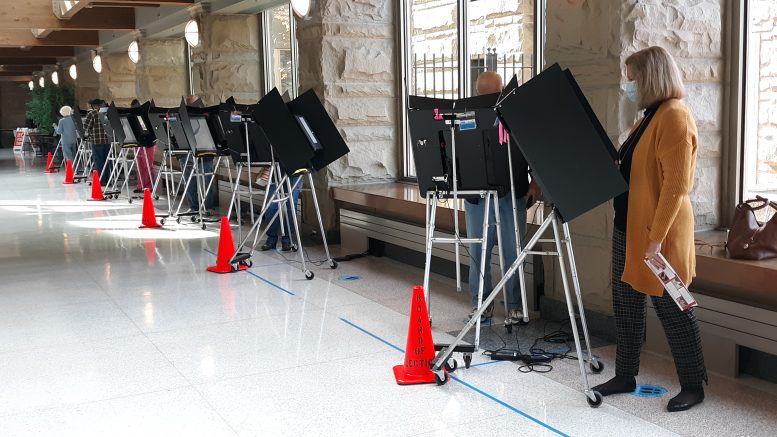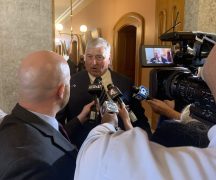State elections officials and poll workers across the country never got their due in 2020. They ran one of their best elections, a feat that was overtaken by the circus trumpeting the Big Lie about a stolen election rife with fraud. The ringmaster of that ruse used the biggest bully pulpit in the land to shout down the truth about an election conducted exceptionally well. Fact is, those overseeing and implementing the nuts and bolts of statewide elections, from Oregon to Maine, pulled off a fraught general election with flying colors.
The chief elections officers, county boards of election and precinct poll workers, who juggled a raging pandemic, a deluge of mail-in ballots, and the highest voter-turnout in over a century, managed a largely problem-free, highly accurate, presidential election. Despite unprecedented challenges, they did their job to ensure that every vote, legitimately cast by absentee ballot, through early voting, in drop boxes, or on Election Day, was processed and counted. Post-election reviews, audits, recounts, etc., reinforced how meticulously state voting systems operated.
Ohio Secretary of State Frank LaRose crowed about running the most successful election ever with a near-perfect accuracy rate of 99.98%. Other states reported similar triumphs after vote tallies were checked and rechecked. No evidence of massive fraud or systemic voting irregularities ever materialized. All the stories about vote-rigging, corrupt voting machines, Hugo Chavez scheming from the grave, sinister ballot dumps and more were just stories. “There’s a great human capacity for inventing things that aren’t true about elections,” mused LaRose.
By all accounts, the 2020 election was seamless — no major voting issues or technical glitches and notably safe. The nation’s top election security official, a widely respected member of the Trump administration, declared the election “the most secure in American history.” Even Bill Barr, the notorious Trump fixer at the Justice Department, rebuked his boss’s baseless election fraud claims as unsubstantiated.
The election was administered, in the main, with integrity and adherence to time-honored processes that were above reproach and certifiably factual. But before credit could be given or the reality of the election could be appreciated, an alternate reality was concocted by the defeated president to make believe he won. In Trump’s parallel universe, victory was stolen from him by rampant voter fraud. His charade about a fraudulent election morphed into a magical mystery tour (aka, Stop the Steal campaign) that went on the road. Administration members, congressional Republicans and right-wing choruses played backup.
The con, sold to millions of Americans as Gospel truth, worked. It fueled voter resentment, rage and Jan. 6. A narcissist drunk on power and desperate to keep it was willing to destroy democracy to that end. Now the Trump Party, desperate to maintain power and willing to destroy voting rights to that end, is using the very hoax peddled by the ex-president to justify new legislative hurdles to suppress the vote. Under the pretense of restoring voter confidence in the integrity of the electoral process — shaken by GOP lies about sweeping voter fraud costing Trump the election — Republicans in state legislatures nationwide are on a tear to curb the vote. Roughly 361 bills have been introduced in 47 states this year to rectify the fictional failings of the last election with tighter restrictions on voting.
The state measures follow the same playbook: targeting mail voting, adding voter ID requirements, cutting opportunities and access to vote, complicating voter registration, expanding voter purges, etc. If the Trump Party makes it harder for some voters to participate, i.e., the poor, the elderly, the young, communities of color, those who traditionally vote Democratic, perfect. Republicans gain advantage and staying power in future elections. What a sore loser in the White House couldn’t do through litigation and intimidation in 2020, GOP-controlled Statehouses can do through legislation — in time for the midterms.
Pay attention to those driving voting restrictions in Columbus. Will your state representative or senator fight to expand how you vote or choose to make it more difficult? Focus on intent. After the stellar execution of the recent election in Ohio, new voting laws would have to improve upon what worked last time, right? Multiple drop box locations in densely populated Ohio counties would be one such improvement, making voting easier for many far-flung residents. But Ohio Republicans plan to arbitrarily limit drop boxes to one site per county and make them available only 10 days before election — down from 30 in 2020. How is that better for voters, especially those dependent on public transportation?
GOP lawmakers, who acknowledge that Ohio has had “good clean elections without controversy,” insist election bills are routine affairs to make the voting process more secure. Bull. This is not about building on past successes. This is about pulling back, eliminating early, in-person voting the Monday before Election Day, removing a week that Ohioans used to apply for a mail ballot, requiring two forms of ID, instead of one, for online absentee ballot requests. These are hoops to jump through that discourage voting, not encourage it. That’s how you suppress voter engagement.
2020 was a testament to the endurance of free and fair elections run by the book. We don’t need to restore confidence in the voting process. We need to vigorously protect it from politicians consumed with keeping power who are willing to disenfranchise Ohio voters, based on a lie, to that end.
***
Also from Ohio Capital Journal:
Ohio House GOP’s proposed voting law changes, explained
Two Republican lawmakers recently unveiled their election reform bill to colleagues, proposing changes to how Ohioans can register to vote and cast absentee ballots in future elections.
The bill has not yet been introduced, but Reps. Bill Seitz of Green Twp. and Sharon Ray of Wadsworth outlined their proposals in a cosponsor request to fellow members of the Ohio House of Representatives.
Here are some key components to the bill and how the changes would differ from current Ohio election practices: READ MORE
Congressman Tim Ryan to run for U.S. Senate seat
Tim Ryan, the 10-term Democratic congressman from northeast Ohio, announced Monday he will campaign for the U.S. Senate seat currently held by Rob Portman.
Ryan, 47, is the first Democrat to jump in the race. Portman announced earlier this year he would not seek reelection in 2022.
Ryan’s campaign said he would soon embark on a “Workers First Tour” to listen to the challenges facing Ohio workers.
Ryan has served in Congress since 2003. Starting in 2013, he has represented the 13th District, which includes the cities of Youngstown, Warren, Kent, portions of Akron as well as his hometown of Niles.
His margins of victory have narrowed considerably in recent years, as the industrial district grew redder during the Trump years. The latest reelection in 2020 was his tightest margin of victory (around 7.5%) of his career. READ MORE
Drugmaker on rising prices: Don’t look at us
A subsidiary of a leading U.S. drugmaker is reporting that the net cost of its products has been falling. If that’s true, it would appear that drug middlemen and insurers are driving increases in the overall cost of medicine and in consumers’ out-of-pocket costs at the counter.
The report, by Johnson & Johnson subsidiary Janssen Pharmaceuticals, looks at 2020. It’s the fourth annual “transparency report,” which the company says is an attempt to shine a light on what’s forcing up drug costs in the United States.
At first glance, it looks like those prices are rising. An analysis released earlier this year by the Rand Corp. indicated that in 2018, list prices for drugs in the U.S. were 2.56 times as high as in 32 other countries.
But that’s far from the whole story, the Janssen report said, because “list” prices are very often not what is paid for drugs in the United States. READ MORE





